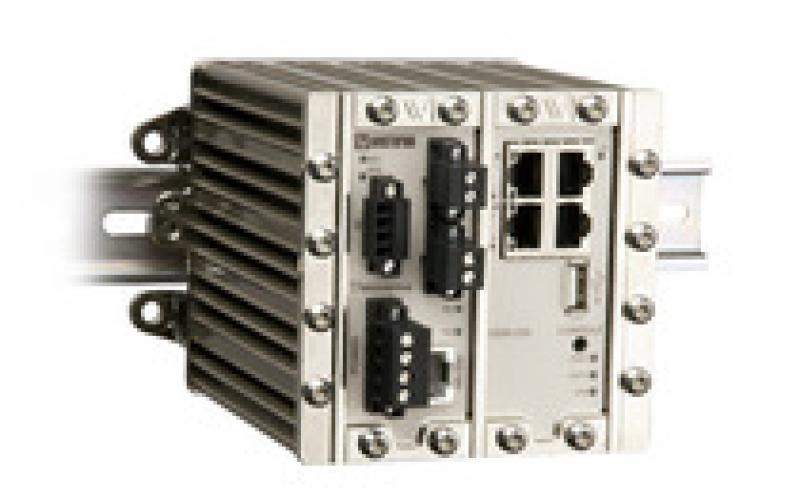- Description
- Downloads
- Parameters
- Dimensions
The Wolverine DDW-226 allows effective Ethernet networks to be created over long distances (up to 15 km) at data rates up to 15.3 Mbit/s. The SHDSL technology makes it possible to reuse many types of pre-existing copper cables which can lead to considerable financial savings. Dependent on cable characteristics, distances up to 15 km (9.3 mi) can be achieved. The combination of WeOS and the integrated RS-232 port allows legacy equipment to become part of an IP backbone network.
With its robust aluminium housing, the DDW-226 is designed for use in heavy duty industrial applications. The wide power range and I/O fault contact make it ideal for easy installation and monitoring in industrial applications. The Transient Blocking Unit (TBU) is acknowledged as the most effective form of protection against damaging noise spikes caused by lightning or high voltage equipment.
Only industrial grade components are used which gives the DDW-226 an MTBF of 700,000 hours and ensures a long service life. A wide operating temperature range of –40 to +70°C (–40 to +158°F) can be achieved without the need for moving parts or cooling holes in the case. The DDW-226 has been tested both by Westermo and external test houses to meet many EMC, isolation, vibration and shock standards, all to the highest levels suitable for heavy industrial environments.
WeOS has been developed by Westermo to allow us to offer cross platform and future proof solutions. WeOS can deliver unique IP security functionality for this class of product e.g. a multiport DMZ can be constructed by utilizing the internal port based firewall function. Remote secure access to a network can be provided using encrypted VPNs.
For resilience, a ring of DDW-226s can be created using the FRNT protocol, or by using OSPF, the DDW-226 can form part of an enterprise network. For more details on WeOS functionality, please see the WeOS datasheet.
| Serial port technology: | Serial port technology Serial Over IP (Serial Extender and Virtual Serial Port) Modem Replacement Modbus Gateway |
| Resiliency and high availability: | Fast Reconfiguration of Network Topology (FRNT) FRNT Link Health Protocol (FLHP) IEEE 802.1D Spanning Tree Protocol (STP) IEEE 802.1w Rapid STP (RSTP) |
| Layer 2 switching: | IEEE 802.1Q Static VLAN and VLAN Tagging IEEE 802.3x Flow Control IGMPv2/v3 snooping AVT Dynamic VLAN (Adaptive VLAN Trunking) Management VLAN (Management Interface concept) Static Multicast MAC filters |
| Layer 2 QoS: | IEEE 802.1p Class of Service Classification |
| IP routing, cyber security, firewall and VPN: | Static IP routing Dynamic IP routing • OSPFv2 • RIPv1/v2 Robust VRRP Stateful Inspection Firewall • NAT • 1-1 NAT • Port Forwarding • ALG Helpers IPSec VPN • IKEv1 • ESP • VPN failover GRE Multinetting Loopback Interface TCP MSS Clamping |
| Manageability: | Management tools • Web interface (HTTP and HTTPS) • CLI via console port and SSHv2 and Telnet • Westermo IPConfig tool • SNMPv1/v2c/v3 • Flexible management of configuration and log files • Secure Copy (SCP) • Local file management via HTTP, FTP, TFTP and SCP • Load/save files from/to USB memory stick Flexible alarm/event handling system Syslog (log files and remote syslog server) Digital I/O Port Monitoring SNTP (NTP client) PPPoE client DHCP client DHCP server DHCP relay agent (DHCP option 82) DDNS |
| SNMP MIB support: | RFC1213 MIB-2 RFC2863 Interface MIB (ifXTable) RFC2819 RMON MIB (etherStatsTable) RFC4188 Bridge MIB RFC4318 RSTP MIB RFC4363 Q-BRIDGE MIB (dot1qVlan and dot1qVlanStaticTable) RFC4836 MAU MIB (dot3IfMauBasicGroup and dot3IfMauAutoNegGroup) RFC4133 Entity MIB (entityPhysical) RFC3433 Entity Sensor MIB WESTERMO PRIVATE MIB |




